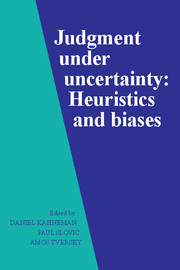Book contents
- Frontmatter
- Contents
- List of contributors
- Preface
- Part I Introduction
- 1 Judgment under uncertainty: Heuristics and biases
- Part II Representativeness
- Part III Causality and attribution
- Part IV Availability
- Part V Covariation and control
- Part VI Overconfidence
- Part VII Multistage evaluation
- Part VIII Corrective procedures
- Part IX Risk perception
- Part X Postscript
- References
- Index
1 - Judgment under uncertainty: Heuristics and biases
Published online by Cambridge University Press: 05 May 2013
- Frontmatter
- Contents
- List of contributors
- Preface
- Part I Introduction
- 1 Judgment under uncertainty: Heuristics and biases
- Part II Representativeness
- Part III Causality and attribution
- Part IV Availability
- Part V Covariation and control
- Part VI Overconfidence
- Part VII Multistage evaluation
- Part VIII Corrective procedures
- Part IX Risk perception
- Part X Postscript
- References
- Index
Summary
Many decisions are based on beliefs concerning the likelihood of uncertain events such as the outcome of an election, the guilt of a defendant, or the future value of the dollar. These beliefs are usually expressed in statements such as “I think that …,” “chances are …,” “it is unlikely that …,” and so forth. Occasionally, beliefs concerning uncertain events are expressed in numerical form as odds or subjective probabilities. What determines such beliefs? How do people assess the probability of an uncertain event or the value of an uncertain quantity? This article shows that people rely on a limited number of heuristic principles which reduce the complex tasks of assessing probabilities and predicting values to simpler judgmental operations. In general, these heuristics are quite useful, but sometimes they lead to severe and systematic errors.
The subjective assessment of probability resembles the subjective assessment of physical quantities such as distance or size. These judgments are all based on data of limited validity, which are processed according to heuristic rules. For example, the apparent distance of an object is determined in part by its clarity. The more sharply the object is seen, the closer it appears to be. This rule has some validity, because in any given scene the more distant objects are seen less sharply than nearer objects.
- Type
- Chapter
- Information
- Judgment under UncertaintyHeuristics and Biases, pp. 3 - 20Publisher: Cambridge University PressPrint publication year: 1982
- 494
- Cited by

